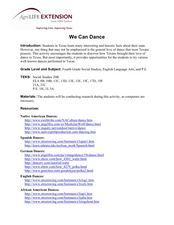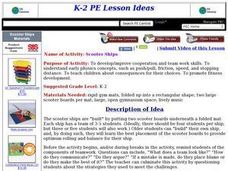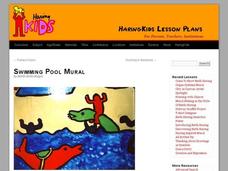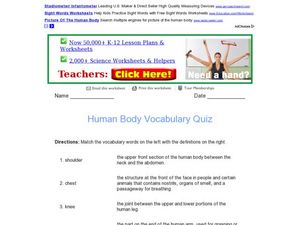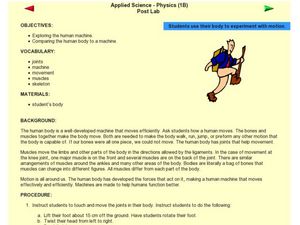PEGAMES.org
Alphabet Aerobics
Whether using the alphabet, songs, poems, or rhymes, give your learners an opportunity to get their minds and bodies moving with this fun activity. This can be adapted to a range of movements or topics that you might like to incorporate,...
Curated OER
Plate Tectonics: Third Grade Lesson Plans and Activities
Third graders examine plate movements and boundaries with a lab that demonstrates how volcanoes and earthquakes are formed. It presents different types of stresses an object can withstand through a hands-on...
Cengage Learning
COVID-19: What Can I Do?
Eleven slides make up a presentation that details the importance of practicing social distancing and what can be done at home during the COVID-19 pandemic. Scholars take part in the classroom discussion highlighting topics such as...
Curated OER
We Can Dance!
Students explore a variety of creative body movements and practice speaking the terms used to demonstrate the movements and shapes. The creation of a video provides an opportunity to learn the vocabulary and practice their speech.
Curated OER
Congruent Polygons: Copying Stretchy Shapes
Third graders investigate congruent polygons through dance. In this congruency lesson, 3rd graders do the "brain dance" as a warm up. They review polygon names by singing "The Polygon Chant," before mirroring congruent shapes with a...
Scholastic
Study Jams! Skeletal System
A dazzling display colorful computer-generated images, x-rays, and photographs create a comprehensive introduction to the skeletal system. With 12 slides in all, aspiring anatomists learn that there are 206 bones in the human body and...
Curated OER
Everybody Is Unique: A Lesson in Respect for Others' Differences
Learners of all ages talk about the meaning of the word "unique," and draw a truly unique person, one part at a time. They create a totally unique person, with a head drawn by one student, a torso drawn by another student, and lower body...
Curated OER
Spark Activity: Basic Body Positions
Students practice basic body positions by moving to music using a locomotive skill called out by the teacher. Students move to a new spot when the music stops, and continue the game as new movements are called. Students discuss body...
Curated OER
Body Movements
In this body movements worksheet, students see pictures of 14 body movements such as abduction and adduction, inversion and eversion, flexion and extension and pronation and supination.
Curated OER
-Body in Motion - Axial and Locomotor
Students practice increasing their movement and dance vocabulary through axial motion and locomotor step skill-building. They work with a partner and create and perform short sequences utilizing the vocabulary their practicing. Each...
Curated OER
Scooter Ships
Students explore simple physics concepts such as push/pull, friction, and speed. In this physics/physical education lesson, students work in co-operative groups to "build" a spaceship out of scooters and folded mats. Teams experiment...
Curated OER
Swimming Pool Mural
Students research art analysis by creating a mural in their class. In this artistic expression lesson, students research the work of Keith Haring and discuss his personal style and how it reflected body movement. Students utilize...
Curated OER
Move Your Muscles!
Students, through teacher lecture and class discussion, explore the three different types of muscles in the human body and the effects of microgravity on these muscles. They explain what happens to muscles in outer space and describe the...
Curated OER
Exploring and Using Shapes to Make a Dance
Second graders use their bodies to create various shapes to make a dance when given various music and beats. In this shapes and dance lesson plan, 2nd graders create lines, curves, twists, and angles with their bodies.
Curated OER
Dancing With Props
Students use move a prop by moving their bodies. They are encouraged to focus on balance, a variety of body movements, and making the prop central to their movements.
Curated OER
Butterflies Fly!
Chopin was a lovely composer who played the piano masterfully. Third graders are introduced to Chopin, his piano sounds, triple meter, music patterns, movement, and the waltz. They listen to his music while hearing the story Butterflies...
Curated OER
Patterns in Dance and Math
Students analyze how repeated body movements and shapes can represent and extend patterns. In this pattern analysis lesson plan, students discuss patterns in dance, math, and everyday living. Students demonstrate a dance using a sequence...
Curated OER
The Human Body: Bones
Here is an interactive PowerPoint about the skeletal system. The first slide shows the entire skeleton and allows learners to try to name each major bone structure before clicking to show the answer. The following slides provide more...
Curated OER
Human Body Vocabulary
In this human body worksheet, students match words on the left with definitions on the right. Worksheet is labeled as a quiz, but may be used as practice/review.
Curated OER
Music and Movement
Students demonstrate how to instruct a Pre-K class in singing and creative movement. Once they are grouped according to several nursery rhymes, they practice singing the songs and coordinating appropriate movements with the rhythm. The...
Curated OER
Joints Help Us Move
Third graders investigate the three main types of joints in their arms and legs that are in charge of movement. In this human biology lesson, 3rd graders view x-rays online to see how different joints look, participate in exercises...
Curated OER
Human Machine
Students explore the human body by conducting an exercise in class. In this human anatomy lesson plan, students view a diagram of the human body and identify the specific bones and joints that allow us to perform specific exercises like...
Nemours KidsHealth
Fitness: Grades K-2
Learners complete movements and discuss how fitness is beneficial to their health. For this fitness lesson plan, students also discuss being safe while moving and take a quiz.
Curated OER
Biomechanics of Sports
Students examine the body's major organ systems and how they function and influence each other. They examine how the human body moves when involved in sports.



